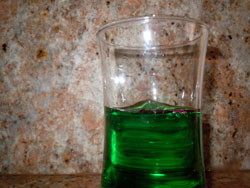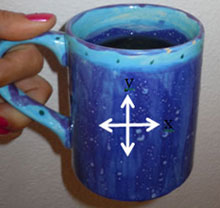The cup-in-hand walk
Have you ever done the cup-in-hand walk, and spilled your drink? It’s a common event. The Krechetnikov Fluid Physics Lab at the University of California in Santa Barbara usually doesn’t focus on this type of problem, but after seeing enough people doing the cup-in-hand walk and spilling, they decided to look into it.1 The research focused on cylindrical shaped cups used commonly to hold coffee, tea, or hot cocoa. The problem involves complex motions, but is solvable.
 (a) |
 (b) |
Figure 1: (a) liquid motion back and forth and (b) up and down.
Some physics
Pendula are commonly discussed in physics classes. Historically they were used to keep time. The most popular pendulum is a swing. Sit on a swing and give it a push and it goes back and forth. Because the swing is connected to a fixed point with string or chain it moves along a circular path. The initial push moves the swing in the direction of the push, and the tension in the string pulls the swing upward. Then Earth’s gravity pulls the swing downward. This process continues until the initial energy imparted to the swing is dissipated to the environment. However, if you continually push the swing by pumping your legs, then you keep it in motion, and if you make sure you pump your legs at just the right time, then you can make the swing go higher. Swinging by pumping your legs is an example of what scientists call a driven oscillator.
When you walk, even though you may only be going in one direction along the floor, there is still a back and forth, or oscillatory, motion to your walk. Walking in and of itself is a complicated motion. The body rotates slightly along the head-to-foot axis, moves a bit up and down with each step, and arms tend to move about the joints (shoulder, elbow, wrist). When you walk with a cup full of fluid in your hand your walking motion changes a bit, for example, there is less rotation about all of the arm joints. Some of the motion energy of walking gets transferred to the cup and to the fluid in the cup. Try it out!
Think back to the swing. If you pump your legs at the wrong time the swing does not get any higher. If you pump them at just the right time (dependent on where the swing is located) you go higher. It turns out that the coffee cup has similar features. If you input energy at just the right time, you can make the liquid in the cup go higher. It turns out that the combination of the cup dimensions and common walking makes for just the right combination to get spills.
The research

Figure 2: Holding cup of coffee showing the x-axis, which is parallel to the floor and the y-axis, which is vertical from the floor. The z-axis, (perpendicular and into and out of the surface of this image) was not measured.
How do you get data for such an event? Take a video! Then process the time frames to get the time and location of the coffee and person, as well as the velocities, and accelerations. The researchers had people walk naturally with an average speed between 0.5 and 2.5 meters per second, while either focusing on the cup or not focusing on the cup. The researchers focused on taking measurements of the vertical motion of the cup and the motion of the cup parallel to the floor, as shown in the image at right.
The cup was rigged such that a light would turn on whenever the fluid in it reached the rim. The circuit consisted of a lead (a sensor) connected to the rim of the cup, an LED that lit up when the circuit was closed, and a conducting fluid in the cup, which closed the circuit when it reached the rim. The conducting fluid was just coffee mixed with salt.
After analyzing their data they found that all directions show an oscillatory type of motion in the cup, however not all contribute in the same way to a spill event. The researchers considered the natural frequencies of oscillation for the cylindrical cup under ideal situations (no friction, incompressible fluid, no swirling), which are well known from studies pertaining to things like rocket fuel canisters. The dimensions of coffee cups usually have a radius of 2.5 cm and height of 5.7 cm to a radius of 6.7 cm and a height of 8.9 cm. The most common cup studied had a radius of 3.5 cm and a height of 10 cm. Remember that the dimensions of the cup are like the parameters of a swing. You pump your legs during swinging at just the right time, which is determined by the length of the swing and where you are in your swinging motion. If the liquid is to increase in amplitude in the cup then the cup must be "pumped" by the walking movements at just the right time, which is determined by the cup’s dimensions.


Figure 3 (a) the acceleration of the cup parallel to the floor. It is the initial acceleration of this motion that causes the first sloshing in the cup. (b) The acceleration of the cup perpendicular to the floor, which does not contribute to the spill factor. Shaded regions show where relative constant walking speed has been attained.
Images courtesy of the Krechetnikov Fluid Physics Lab at the University of California in Santa Barbara.
What they found is that the initial back-and-forth motion from walking forward affects the initial sloshing or displacement of liquid along the side of the cup. The side-to-side or lateral motion of walking affects the liquid oscillations when the motion is close to the natural oscillations that are allowed by the cup dimensions, but these are not as close to as the forward-back motions of stepping. The vertical motions do not contribute significantly to the natural oscillations of the liquid in the cup. Surprisingly the natural oscillations of forward stepping motion coincide well with the natural oscillations allowed for common cup dimensions. What does this mean? That walking tends to "pump" the back and forth motion of the liquid in the cup at just the right time so that it increases in height along the cup’s side. Eventually it reaches the rim and spills. This result implies we need some new cup designs, or perhaps we shouldn’t walk around with our cups!
The research also noted that most coffee spilling occurs within the first 7 to 10 steps (4 to 5 meters) of walking, and occurs earlier when people quickly reach their regular walking speed (their initial acceleration). The initial acceleration causes the initial displacement of liquid in the cup. The bigger the initial acceleration, the bigger the initial displacement of the fluid in the cup.
It turns out that the more focused you are on the cup and spilling, the less likely you are to spill. These subjects reached their regular walking speeds more slowly. The initial displacement of liquid was less, and they required more steps before the height of the liquid along the side of the cup increased to the rim. Also, you can alter your movement if you see the fluid nearing the rim.
Future research and applications
This research suggests a few things. The first two may seem obvious: Don’t fill a cup too much if you are going to walk with it; If you are walking with a cup of liquid focus on it and adjust your motion if you see it is about to spill. The less obvious suggestions deal with improvements on cup designs that would reduce the resonant oscillations. Suggestions on cup design improvements include: flexible coffee cups, a series of ringed ridges along the inside of the cup, or broken ridged rings along the inside of the cup. All these cup design suggestions would dissipate the energy of the oscillations so the fluid would not reach the rim and spill.
References, resources, and links
1. Mayer, H.C. and Krechetnikov, R, Walking with Coffee: Why does it spill?, Physical Review E, 85, pp. 046117-046124 (2012)
DOI: 10.1103/PhysRevE.85.046117
2. The Physics of Coffee Spills, University of California Santa Barbara Research, Profiles in Research.
3. Thomas, J., Synopsis: Science of Slosh, Physics, 26 April 2012.
4. Cartwright, J., The Physics of Spilled Coffee, Science Now, 4 May 2012
5. Choi, Charles Q., Physicists Dive into Oscillation Frequency of Coffee, Scientific American, 22 November 2011.
H.M. Doss














